Whether fiction or nonfiction, adventure and survival stories are welcome additions to classroom and library collections. This collection of reviews includes humans, other animals, and even a few fantasy creatures in adventures—large and small—and incredible stories of survival that are good choices for either reading aloud or reading independently.
Ages 4–8
Lucy & Company. Marianne Dubuc. 2016. Kids Can.
 In three episodic stories, Lucy and Company share mini-adventures. In “The Snack,” Lucy makes four new friends—Marcel, a mouse; Henry, a rabbit; Dot, a tortoise; and Adrian, a snail—when they share snack time on a tree branch. In “The Treasure Hunt,” Lucy finds a treasure map, and after mistaking sleeping Anton, a bear, for the rock by the red X on the map, they dig up a surprise, a birthday treasure for Henry. In “The Hatchlings,” when chicks hatch from three eggs Adrian has discovered, the friends need to find a cozy spot to keep them warm, and this time the surprise is on Anton. Sunny pencil-and-watercolor illustrations show Lucy and her animal friends, with rosy cheeks and smiles, enjoying their time together in the woods.
In three episodic stories, Lucy and Company share mini-adventures. In “The Snack,” Lucy makes four new friends—Marcel, a mouse; Henry, a rabbit; Dot, a tortoise; and Adrian, a snail—when they share snack time on a tree branch. In “The Treasure Hunt,” Lucy finds a treasure map, and after mistaking sleeping Anton, a bear, for the rock by the red X on the map, they dig up a surprise, a birthday treasure for Henry. In “The Hatchlings,” when chicks hatch from three eggs Adrian has discovered, the friends need to find a cozy spot to keep them warm, and this time the surprise is on Anton. Sunny pencil-and-watercolor illustrations show Lucy and her animal friends, with rosy cheeks and smiles, enjoying their time together in the woods.
—CA
Poles Apart. Jeanne Willis. Ill. Jarvis. 2016. Nosy Crow/Candlewick.
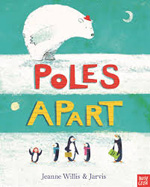 On an outing, the Pilchard-Browns, a penguin family, become lost and end up at the North Pole (a 12,430-mile wrong turn), where they meet Mr. White, a polar bear wearing a tiny, red bowler. When Mr. Pilchard-Brown admits to his map-reading mistake, Mr. White says, “Don’t think of it as a mistake. Think of it as the start of a big adventure.” When he offers to help them get back home, the penguins follow Mr. White over land and sea, visiting the United States, England, Italy, India, and Australia, before reaching the South Pole. Once he’s back, Mr. White is happy to have fulfilled his dream of being the first polar bear to reach the South Pole, but sad that he’ll never see another penguin. What follows will be a surprise except for those who have been paying close attention to the details of the clever illustrations (Hint: Keep an eye on Mr. White’s hat.).
On an outing, the Pilchard-Browns, a penguin family, become lost and end up at the North Pole (a 12,430-mile wrong turn), where they meet Mr. White, a polar bear wearing a tiny, red bowler. When Mr. Pilchard-Brown admits to his map-reading mistake, Mr. White says, “Don’t think of it as a mistake. Think of it as the start of a big adventure.” When he offers to help them get back home, the penguins follow Mr. White over land and sea, visiting the United States, England, Italy, India, and Australia, before reaching the South Pole. Once he’s back, Mr. White is happy to have fulfilled his dream of being the first polar bear to reach the South Pole, but sad that he’ll never see another penguin. What follows will be a surprise except for those who have been paying close attention to the details of the clever illustrations (Hint: Keep an eye on Mr. White’s hat.).
—CA
Return (Journey #3). Aaron Becker. 2016. Candlewick.
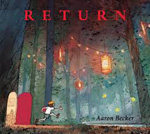 In this conclusion to his wordless trilogy, Becker’s spectacular watercolor-and-ink artwork invites readers to join the lonely girl who fails to get the attention of her preoccupied artist father as she uses a red crayon to draw a door through which she returns to a fantastical kingdom. This time, however, her father follows, and they share adventures in which he becomes a hero by thwarting a villain who is wielding a contraption that destroys crayon magic. With crayon magic restored in the kingdom, father and daughter return to their home. The final page suggests that their time together in this fantasy world has resulted in a bonding that will have them spending more time together.
In this conclusion to his wordless trilogy, Becker’s spectacular watercolor-and-ink artwork invites readers to join the lonely girl who fails to get the attention of her preoccupied artist father as she uses a red crayon to draw a door through which she returns to a fantastical kingdom. This time, however, her father follows, and they share adventures in which he becomes a hero by thwarting a villain who is wielding a contraption that destroys crayon magic. With crayon magic restored in the kingdom, father and daughter return to their home. The final page suggests that their time together in this fantasy world has resulted in a bonding that will have them spending more time together.
—CA
Ages 9–11
I Survived: The Hindenburg Disaster, 1937 (I Survived #13). Lauren Tarshis. Ill. Scott Dawson. 2016. Scholastic.
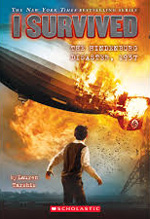 It is 7:25 p.m. on May 6, 1937. Tarshis begins this I Survived book with a dramatic statement: “In seconds, the Hindenburg would explode.” The story of the three-day journey of the Hindenburg, a German zeppelin, across the Atlantic Ocean that ended in disaster in New Jersey is narrated by 11-year-old Hugo Ballard. Hugo’s family is traveling to America, seeking a cure for his 4-year-old sister, Gertie, who contracted malaria in Kenya. Also aboard is Nazi Colonel Kohl, who is searching for a spy. When Gertie takes a turn for the worse and asks him to bring their dog, Panya, to her, Hugo, who has had a tour of the airship, sneaks into the cargo area. There he encounters and befriends the spy whom Kohl is trying to capture. Hugo’s story is fictional, but it is based upon historical facts related to the Hindenburg disaster in which some passengers and crew members did survive. Back matter includes an author’s note, a timeline of events leading up to the Hindenburg’s explosion, a Q & A section with the author, a bibliography, and a list of resources.
It is 7:25 p.m. on May 6, 1937. Tarshis begins this I Survived book with a dramatic statement: “In seconds, the Hindenburg would explode.” The story of the three-day journey of the Hindenburg, a German zeppelin, across the Atlantic Ocean that ended in disaster in New Jersey is narrated by 11-year-old Hugo Ballard. Hugo’s family is traveling to America, seeking a cure for his 4-year-old sister, Gertie, who contracted malaria in Kenya. Also aboard is Nazi Colonel Kohl, who is searching for a spy. When Gertie takes a turn for the worse and asks him to bring their dog, Panya, to her, Hugo, who has had a tour of the airship, sneaks into the cargo area. There he encounters and befriends the spy whom Kohl is trying to capture. Hugo’s story is fictional, but it is based upon historical facts related to the Hindenburg disaster in which some passengers and crew members did survive. Back matter includes an author’s note, a timeline of events leading up to the Hindenburg’s explosion, a Q & A section with the author, a bibliography, and a list of resources.
—NB
The Kidnap Plot (The Extraordinary Journeys of Clockwork Charlie #1). Dave Butler. 2016. Alfred A. Knopf/Random House.
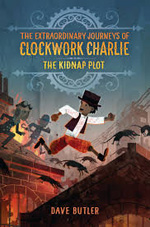 Ten-year-old Charlie Pondicherry is living a sequestered life in Victorian England when his father, an inventor and clockmaker, is kidnapped by the underground Anti-Human League. On a quest to find his father, Charlie bravely enlists the aid of two aeronauts (customers of his father), a gigantic troll, and a pixie. Thrown headfirst into a steampunk adventure, Charlie and his motley crew unexpectedly uncover an even more nefarious scheme against Queen Victoria that they must stop. In this fast-paced adventure, Charlie finds that courage, family, and friendship are necessary for overcoming evil and also discovers something unbelievable about his own identity.
Ten-year-old Charlie Pondicherry is living a sequestered life in Victorian England when his father, an inventor and clockmaker, is kidnapped by the underground Anti-Human League. On a quest to find his father, Charlie bravely enlists the aid of two aeronauts (customers of his father), a gigantic troll, and a pixie. Thrown headfirst into a steampunk adventure, Charlie and his motley crew unexpectedly uncover an even more nefarious scheme against Queen Victoria that they must stop. In this fast-paced adventure, Charlie finds that courage, family, and friendship are necessary for overcoming evil and also discovers something unbelievable about his own identity.
—NB
Survivors: Swamp: Louisiana, 1851. Kathleen Duey & Karen A. Bale. 2016. Aladdin/Simon & Schuster.
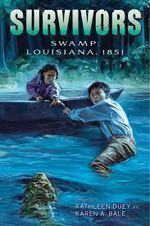 It’s 1851 in the Bayou Teche in Louisiana, and life isn’t fair for 12-year-old Lily LeGrand or her Cajun community. Lily, born with a lame foot, has been cruelly bullied by the twin sons, William and Mark, of the Courville plantation, who follow in their father’s prejudiced footsteps. After Paul Courville, the youngest son, befriends Lily against the twins’ latest painful prank, they haul him to the swamp where they abandon him, only to find themselves lost, too. When Lily hears that Paul has gone missing, she knows she can use her knowledge of the swamp to save him. Against her father’s orders, Lily sneaks out into the treacherous terrain filled with danger at every turn to rescue Paul—and finds even more than she expected. Young readers will be drawn into this thrilling story about a young heroine who selflessly fights to save her friend’s life.
It’s 1851 in the Bayou Teche in Louisiana, and life isn’t fair for 12-year-old Lily LeGrand or her Cajun community. Lily, born with a lame foot, has been cruelly bullied by the twin sons, William and Mark, of the Courville plantation, who follow in their father’s prejudiced footsteps. After Paul Courville, the youngest son, befriends Lily against the twins’ latest painful prank, they haul him to the swamp where they abandon him, only to find themselves lost, too. When Lily hears that Paul has gone missing, she knows she can use her knowledge of the swamp to save him. Against her father’s orders, Lily sneaks out into the treacherous terrain filled with danger at every turn to rescue Paul—and finds even more than she expected. Young readers will be drawn into this thrilling story about a young heroine who selflessly fights to save her friend’s life.
—NB
Ages 12–14
Girl on a Plane. Miriam Moss. 2016. Houghton Mifflin Harcourt.
 In September 1970, 15-year-old Anna boards a British Overseas Airways plane in Bahrain to fly back to boarding school in England. The plane is hijacked by the Popular Front for the Liberation of Palestine (PFLP), and the pilot is forced to land on an isolated airstrip in the Jordanian desert. The guerillas threaten to blow up the plane and kill all the passengers in three days if their demand for the release of a PFLP member imprisoned in England is not met. In addition, with the plane’s power cut off, passengers suffer from extreme daytime heat and nighttime cold, and as food and water supplies are exhausted, Anna faces the possibility that she may not live to see her family again. This novel is based on Moss’s personal story of surviving the hijacking of a plane by Palestinian terrorists in 1970.
In September 1970, 15-year-old Anna boards a British Overseas Airways plane in Bahrain to fly back to boarding school in England. The plane is hijacked by the Popular Front for the Liberation of Palestine (PFLP), and the pilot is forced to land on an isolated airstrip in the Jordanian desert. The guerillas threaten to blow up the plane and kill all the passengers in three days if their demand for the release of a PFLP member imprisoned in England is not met. In addition, with the plane’s power cut off, passengers suffer from extreme daytime heat and nighttime cold, and as food and water supplies are exhausted, Anna faces the possibility that she may not live to see her family again. This novel is based on Moss’s personal story of surviving the hijacking of a plane by Palestinian terrorists in 1970.
—CA
A Storm Too Soon: A Remarkable True Survival Story in 80-Foot Seas (True Storm Rescues). Michael J. Tougias. 2016. Christy Ottaviano/Henry Holt.
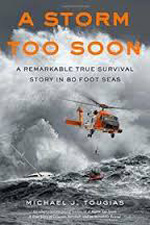 This adaptation for young readers of A Storm Too Soon: A True Story of Disaster, Survival, and an Incredible Rescue (2013) is the story of three sailors who set out from Florida on May 2, 2007, to cross the Atlantic Ocean to France on a 44-foot sailboat named Sean Seamour II. Three weeks before the official start of the 2007 Atlantic hurricane season, they encounter the fury of the unpredicted extratropical cyclone that evolved into subtropical storm Andrea. When the Sean Seamour II sinks, the three are set adrift on a life boat in 80-foot waves. The story of their life-threatening ordeal and the heroism of their rescuers, the four members of a Coast Guard Jayhawk helicopter crew, takes readers on an unforgettable adventure at sea.
This adaptation for young readers of A Storm Too Soon: A True Story of Disaster, Survival, and an Incredible Rescue (2013) is the story of three sailors who set out from Florida on May 2, 2007, to cross the Atlantic Ocean to France on a 44-foot sailboat named Sean Seamour II. Three weeks before the official start of the 2007 Atlantic hurricane season, they encounter the fury of the unpredicted extratropical cyclone that evolved into subtropical storm Andrea. When the Sean Seamour II sinks, the three are set adrift on a life boat in 80-foot waves. The story of their life-threatening ordeal and the heroism of their rescuers, the four members of a Coast Guard Jayhawk helicopter crew, takes readers on an unforgettable adventure at sea.
—CA
To Stay Alive: Mary Ann Graves and the Tragic Journey of the Donner Party. Skila Brown. 2016. Candlewick.
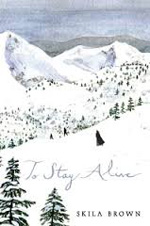 Nineteen-year-old Mary Ann Graves, an actual survivor of the ill-fated crossing of the Sierra Nevada range by members of the Donner Party, is the narrator of this novel in verse. In the spring of 1846, Mary Ann is excited to set out with her family as they leave their home in Illinois to travel west to California. The lyrical language of Brown’s poetry conveys the hardships the wagon train encounters as it moves across the vast wilderness and then the unexpected harshness of an early winter, which brings a shift from enthusiasm for a trailblazing adventure to despair among the starving and freezing pioneers. Back matter includes an author’s note on historical context and a list of the families in the Donner Party.
Nineteen-year-old Mary Ann Graves, an actual survivor of the ill-fated crossing of the Sierra Nevada range by members of the Donner Party, is the narrator of this novel in verse. In the spring of 1846, Mary Ann is excited to set out with her family as they leave their home in Illinois to travel west to California. The lyrical language of Brown’s poetry conveys the hardships the wagon train encounters as it moves across the vast wilderness and then the unexpected harshness of an early winter, which brings a shift from enthusiasm for a trailblazing adventure to despair among the starving and freezing pioneers. Back matter includes an author’s note on historical context and a list of the families in the Donner Party.
—CA
Ages 15+
Invisible Fault Lines. Kristen-Paige Madonia. 2016. Simon & Schuster.
 Callie’s father inexplicably disappears one day. No one knows where he is, and she is in mourning for him. Her mind runs over possibilities: Did he have an accident at the construction site where he worked? Is he wandering somewhere with amnesia? Because authorities can’t locate him, Callie decides to investigate on her own. She stumbles across an exhibit on the 1906 San Francisco Earthquake with what appears to be a photograph of her father in it. Is this a coincidence? Did he have an ancestor living during that time? Told from both Callie’s point of view and that of the man in the photo, this novel blends historical fiction with the reality of bereaved Callie, a 16-year-old girl living in present-day San Francisco and searching desperately for her father.
Callie’s father inexplicably disappears one day. No one knows where he is, and she is in mourning for him. Her mind runs over possibilities: Did he have an accident at the construction site where he worked? Is he wandering somewhere with amnesia? Because authorities can’t locate him, Callie decides to investigate on her own. She stumbles across an exhibit on the 1906 San Francisco Earthquake with what appears to be a photograph of her father in it. Is this a coincidence? Did he have an ancestor living during that time? Told from both Callie’s point of view and that of the man in the photo, this novel blends historical fiction with the reality of bereaved Callie, a 16-year-old girl living in present-day San Francisco and searching desperately for her father.
—NB
Learning to Swear in America. Katie Kennedy. 2016. Bloomsbury.
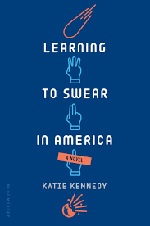 Disaster is imminent. The stakes are life or death for 17-year-old Dr. Yuri Strelnikov, a Russian physics prodigy in the running for the Nobel Prize, whose work on antimatter could save Southern California from being destroyed by an asteroid. Yuri is assigned to a team of middle-aged NASA scientists in Pasadena, California, who refuse to listen to him or consider his solution. Dismayed to discover that a colleague in Russia has absconded with his work, Yuri is anxious to return home to defend his research but discovers that the United States, which is practically treating him like a prisoner, does not plan to release him to Russia after D-Day (if they don’t all perish in the collision). When he meets Dovie and her brother, lonely Yuri learns there is more to life than math and science. He finally has a personal reason to survive, but will he be able to circumvent NASA’s ill-conceived plans in time—and is he right?
Disaster is imminent. The stakes are life or death for 17-year-old Dr. Yuri Strelnikov, a Russian physics prodigy in the running for the Nobel Prize, whose work on antimatter could save Southern California from being destroyed by an asteroid. Yuri is assigned to a team of middle-aged NASA scientists in Pasadena, California, who refuse to listen to him or consider his solution. Dismayed to discover that a colleague in Russia has absconded with his work, Yuri is anxious to return home to defend his research but discovers that the United States, which is practically treating him like a prisoner, does not plan to release him to Russia after D-Day (if they don’t all perish in the collision). When he meets Dovie and her brother, lonely Yuri learns there is more to life than math and science. He finally has a personal reason to survive, but will he be able to circumvent NASA’s ill-conceived plans in time—and is he right?
—NB
Nancy Brashear is Professor Emeritus of English from Azusa Pacific University, in Azusa, CA. Carolyn Angus is former director of the George G. Stone Center for Children's Books, Claremont Graduate University, in Claremont, CA.
These reviews are submitted by members of the International Literacy Association's Children's Literature and Reading Special Interest Group (CL/R SIG) and are published weekly on Literacy Daily.